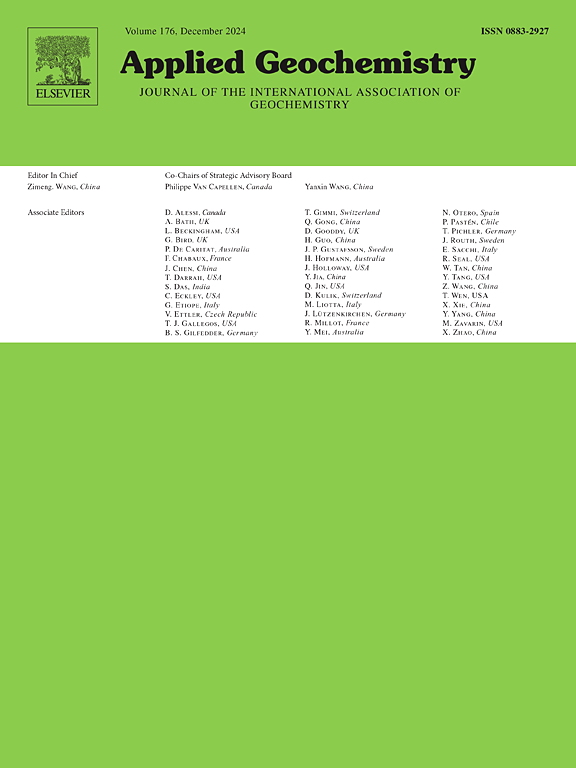塞浦路斯特罗多斯山脉历史石棉矿周围的水成分演化
IF 3.4
3区 地球科学
Q1 GEOCHEMISTRY & GEOPHYSICS
引用次数: 0
摘要
历史悠久的Amiantos温石棉矿(1988年关闭)位于Troodos山脉,坐落在构成Artemis Diapir的蛇纹岩中。在更新世-全新世底辟隆升期间,寄主岩石被广泛剪切和角化,使大气水得以渗透。蛇纹石矿脉,特别是纤维状温石棉,在整个隆升历史中形成,伴随有碳酸盐和碳酸盐表面沉淀,形成于春季。Artemis Diapir与奥林匹斯Diapir的部分蛇形橄榄岩的断层并列,形成了Troodos山脉的最高海拔(1952米)。河流和浅层地下水排水Artemis Diapir具有高浓度的Mg2+和溶解无机碳(DIC),少量Ca2+和pH 8-10。此外,这些水体具有高浓度的Na+、K+、Cl−、SO42−和微量元素Cs、Ba、Br、B和Li,这些元素来自于寄主蛇纹岩中矿物包裹体的溶解。这些溶解的成分覆盖了在当地大气降水中出现的低水平的海洋气溶胶。由于与矿山有关的粉碎造成更高的渗透性和更小的颗粒尺寸,地表水通过石棉矿山尾矿,局部增强了这些元素的溶解。所有地表水的温石棉(log Q/K = 3-9)和碳酸盐矿物,特别是菱镁矿(log Q/K = 1-2)均呈强过饱和状态。在干旱季节,蒸发的碳酸盐沉淀物偶尔会在河床和尾矿表面形成。在陡峭的山地环境中,雨水事件对矿山尾矿和易碎的宿主岩的侵蚀使温石棉碎屑成为溪流沉积物,具有风成再活化的潜力。岩石和矿山残留物中已经存在的相对丰富的碳酸盐,加上地表水中碳酸盐和温石棉的过饱和,限制了这些材料通过增强风化和矿物碳酸化来捕获二氧化碳的功效。本文章由计算机程序翻译,如有差异,请以英文原文为准。

Water compositional evolution around a historic asbestos mine, Troodos mountains, Cyprus
The historic Amiantos chrysotile asbestos mine (closed 1988) in the Troodos mountains, is hosted in serpentinites that constitute the Artemis Diapir. Host rocks were extensively sheared and brecciated during Pleistocene-Holocene diapiric uplift, enabling penetration of meteoric waters. Veins of serpentine minerals, especially fibrous chrysotile, have formed throughout this uplift history with accompanying carbonates, and carbonate surface precipitates that form at spring sites. The Artemis Diapir is juxtaposed by faults against less-permeable partially serpentinised peridotites of the Olympus Diapir that forms the highest elevation (1952 m) of the Troodos Mountains. Streams and shallow groundwater draining the Artemis Diapir have high concentrations of Mg2+ and dissolved inorganic carbon (DIC), minor Ca2+, and pH 8–10. In addition, these waters have high concentrations of Na+, K+, Cl−, SO42− and trace elements Cs, Ba, Br, B, and Li sourced from the dissolution of mineral inclusions in the host serpentinites. These dissolved constituents overprint low levels of marine aerosols that occur in local meteoric precipitation. Passage of surficial waters through asbestos mine tailings have locally enhanced dissolution of these elements because of even higher permeability and small particle size that resulted from mine-related comminution. All surficial waters are strongly supersaturated with respect to chrysotile (log Q/K = 3–9) and carbonate minerals, especially magnesite (log Q/K = 1–2). Evaporative carbonate precipitates form episodically on stream beds and tailings surfaces during dry seasons. Erosion of mine tailings and friable host rocks by rain events in the steep mountain environment contributes detrital chrysotile asbestos to stream sediments, with potential for aeolian remobilization. The relatively high abundance of carbonates already in the rocks and mine residues, combined with carbonate and chrysotile supersaturation in surficial waters, limits the efficacy of these materials for CO2 capture through enhanced weathering and mineral carbonation.
求助全文
通过发布文献求助,成功后即可免费获取论文全文。
去求助
来源期刊

Applied Geochemistry
地学-地球化学与地球物理
CiteScore
6.10
自引率
8.80%
发文量
272
审稿时长
65 days
期刊介绍:
Applied Geochemistry is an international journal devoted to publication of original research papers, rapid research communications and selected review papers in geochemistry and urban geochemistry which have some practical application to an aspect of human endeavour, such as the preservation of the environment, health, waste disposal and the search for resources. Papers on applications of inorganic, organic and isotope geochemistry and geochemical processes are therefore welcome provided they meet the main criterion. Spatial and temporal monitoring case studies are only of interest to our international readership if they present new ideas of broad application.
Topics covered include: (1) Environmental geochemistry (including natural and anthropogenic aspects, and protection and remediation strategies); (2) Hydrogeochemistry (surface and groundwater); (3) Medical (urban) geochemistry; (4) The search for energy resources (in particular unconventional oil and gas or emerging metal resources); (5) Energy exploitation (in particular geothermal energy and CCS); (6) Upgrading of energy and mineral resources where there is a direct geochemical application; and (7) Waste disposal, including nuclear waste disposal.
 求助内容:
求助内容: 应助结果提醒方式:
应助结果提醒方式:


